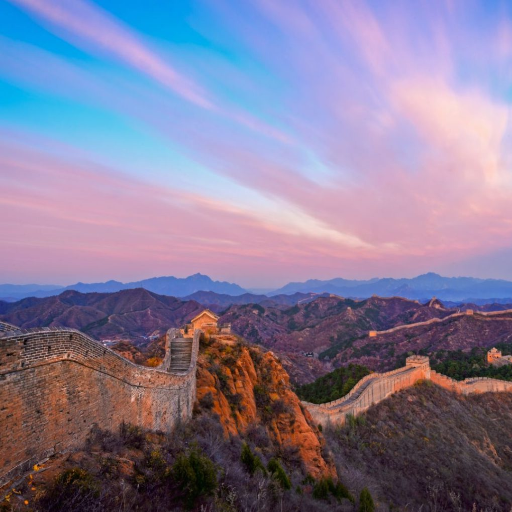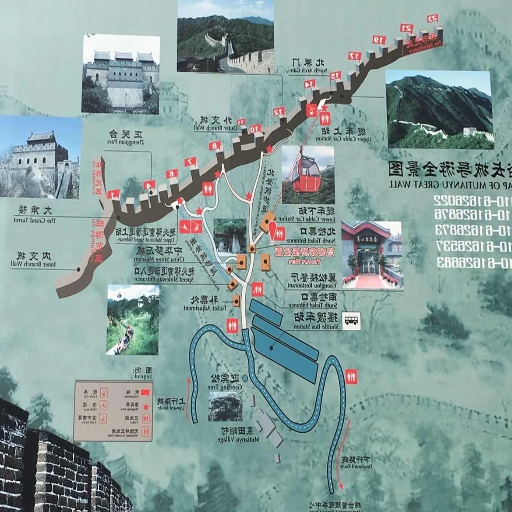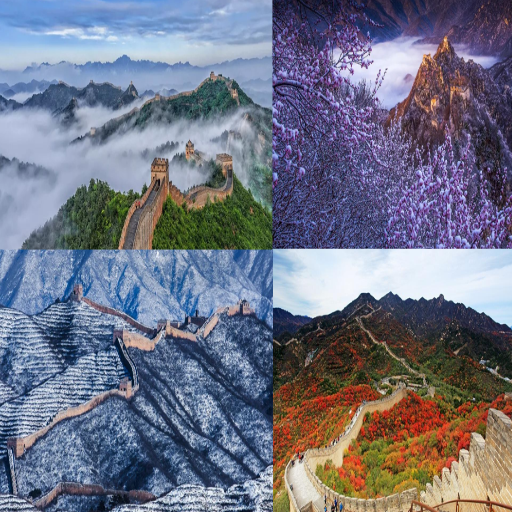Seeing the Great Wall of China is an unforgettable experience thanks to its magnificent views and rich historical significance. If you’re starting your journey from Beijing, you’re up for great fun, but where do you start? With some planning, like knowing which section of the Wall to pick and when to visit to beat the crowds, your trip can be hassle-free and fulfilling. This guide is aimed at helping you plan your tour of the Great Wall by sharing practical recommendations, essential information, valuable tips, and unique insights that will improve your experience. Prepare yourself to discover the most effective methods to enjoy visiting this ancient wonder without the difficulty that usually comes along!
What are the Best Sections of the Great Wall to Visit?

Overview of the Attractions Found in Mutianyu
Blending lovely landscapes and rich history, Mutianyu features one of the most preserved sections of the Great Wall of China, which is famous for its watchtowers—23 in total—which were built by the Ming dynasty. It is easily accessible, located about 45 miles northeast of Beijing, and is perfect for families, children, historians, photographers, and many more. Unlike other busier parts of the Wall, Mutianyu is less frequented and offers calmer surroundings free of the hustle and bustle to appreciate the spectacular views of the dense forests and rolling hills surrounding the wall.
The whole area is equipped with visitor-friendly amenities like a cable car, and the thrilling toboggan ride at Mutianyu provides even more excitement to the historical exploration. Hiking trails catered to all age groups, with varying difficulty levels for every skill level, will delight visitors. Be it autumn when the foliage is vibrant and colorful, or during spring when everything is lush green, Mutianyu provides breathtaking views and unrivaled cultural landmarks.
Comparison of Badaling and Jinshanling
Badaling and Jinshanling are both famous sections of the Great Wall of China, and each has its unique charm. Badaling is the most touristic and the best preserved section. It is located next to Beijing and has wide paths, handrails, and modern amenities like the best bathrooms. As a result, it is primarily a destination for large groups and families with children who want an easy visit. Because of its easy access and fame, it tends to get overcrowded, especially during the peak season.
In contrast, Jinshanling, situated further from Beijing in Hebei Province, is more wild and less touristy. Jinshanling is famous for its partially restored stretches and wild areas of the wall. It is perfect for adventurers and photographers looking to capture the wall in a serene and quieter environment. The trails are more difficult, such as steep hills and original structures that provide insight into the wall. Many people appreciate its panoramic view and ability to escape China’s constant noise and explore the Great Wall in its natural state.
Ultimately, the choice of Jinshanling or Badaling comes down to what a visitor looks for. Badaling works best for family visits and easy accessibility, while Jinshanling attracts those looking for a quieter, more natural experience of nature intermingled with history.
What is Special about Juyongguan
Juyongguan is one of the prominent Great Wall sections due to its strategic value and stunning scenery. Situated in a beautiful valley around 60 kilometers from Beijing, Juyongguan was a significant military site in China. One remarkable characteristic of this section is its round-shaped fortification, a rare architectural feature that ensured a strong defense against invading forces.
Accessibility is an aspect that makes Juyongguan special. The balance between history and modern convenience invites many people. Several elaborately carved and inscribed towers are near the wall beside well-preserved ruins. Cloud Platform, which was adorned with beautiful stone carvings by Buddhists and built during the Yuan dynasty, is another attraction worth visiting. The well-maintained routes and reasonable difficulty level add to the historical exploration, making it ideal for visitors of different fitness capabilities.
What Should I Include in My Great Wall Tour Itinerary?

Must-See Markers of Interest When Close to Beijing
The Badaling Section – The Badaling Section is the most popular and best-preserved part of the Great Wall, where facilities are available and stunning views can be captured. This section is perfect for first-timers.
Mutianyu Great Wall—This section is best known for its beautiful surroundings and fewer crowds. It also has cable cars and renovated watch towers.
Simatai Great Wall—Famous for its unrenovated structure, Simatai is special because of its mix of epic views and history, especially at night when the wall is lit up.
Juyongguan Pass—This Beijing-adjacent site is well-known for its historical value. It and the enchanting Cloud Platform were strategically important and easy to access.
These sites are important because they allow tourists to experience the Great Wall and its different features in one trip close to Beijing.
Popular Activities on a Day Tour
Now that we have noted the must-see sites, let’s examine some popular activities at the Great Wall that are suitable for a day trip.
Hiking Along the Wall: A worthwhile hike to the Great Wall would be an unforgettable experience. Different parts of the Wall have different views. For example, the Mutianyu has renovated pathways, while Jiankou has wild, untamed paths, allowing hikers of all skill levels to enjoy the hike.
Perspective Photography: Subtle nuances of engineering or vast architectural views can be captured during Photography at the Great Wall. Unique to other wall features, the Great Wall offers breathtaking views early in the morning and after 4 PM, as sunlight glints off the structures during those times. The absence of crowds elevates the photogenic experience.
Sightseeing in Cable Cars: Chair lifts and Cable Cars like Mutranou or Badaling are easily accessible for Great Wall sightseeing purposes. They are also easy to access and present an exquisite view of the landscapes from above.
Sampling Regional Delicacies: Touring the Great Wall can be enriching because it is a gateway to some delightful local villages or eateries. The addition of sampling the cuisine best exemplifies the culture of that region during the tour, which makes it more pleasing and enjoyable.
Stargazing and Stargazing (Some Portions): Camping in areas like Simatai allows travelers to spend a night or organize a stay. Night camping illuminated by the wall is unique, yet the opportunity to gaze at stars in calm surroundings is stunning.
The activities listed above can integrate history, culture, and nature with the stunning sights at the wall to make it truly unforgettable. These activities, in particular, can add a refreshing yet multidimensional feel to a day at the Great Wall.
Managing Time for Excursions
A day plan is essential to maximize your time visiting the Great Wall. Make sure you start your day around 7 A.m. to avoid the long queues and crowds and enjoy the more tolerable summer weather. Also, ensure transport to your intended wall section is planned out at least 1.5 to 3 hours in advance. You must have your plan structured so that getting off the Wall entails no less than two hours of walking, during which time breaks for photography or basking in the views are necessary.
Accounting for travel to culturally relevant locations, such as visiting local restaurants or meals, is also essential. Hikes that long, such as the one between Jinshanling and Simatai, will require active time budgeting. If you wish to do stargazing or visit Simatai at night, ensure you have extended rest and sleep built into your schedule. Having elapsed time allocated to hesitating, a more relaxed experience will allow you to take in everything this incredible spot offers fully.
What are the Options for a Private Tour of the Great Wall?

Advantages of Booking A Private Tour
A private tour of the Great Wall combines convenience, desired itineraries, and individualized attention into one unparalleled experience. With a private guide, you are provided with in-depth stories behind the engineering marvels and culture-rich history of one of the most important landmarks of China. Unlike group tours, private tours have the added advantage of setting your own pace, guaranteeing a more relaxed, enjoyable visit. These tours also enable the chance to visit less crowded places like Jiankou, where the rugged beauty of the wall remains untouched.
Moreover, most private tours include the logistical convenience of personal door-to-door transport, exclusive stopovers, and bypass-queue privileges. Whether a photographer is looking for angles or a history buff is looking for details, a private tour allows the customization of the trip to fit their needs. Real-time adjustments, exclusive experiences, and increased comfort during a trip to the Great Wall make private tours highly attractive for tourists.
Flexible Travel Plans For Personal Preferences
The Private Tours of the Great Wall of China ensure that the travel itinerary can be tailored for absolute flexibility concerning an individual’s interests. You can visit the Jiankou section of the Great Wall, if adventurous treks in less-populated regions appeal to you, or you can visit family-friendly Mutianyu, which is more widely known, as both options are available. These tours combine the historical splendor and nature’s beauty, and provide a stop at cultural landmarks, a local village, or a picturesque trail. Timing is also essential. We offer the option of early morning tours to watch the spectacular sunrise and evening tours to enjoy the calmness of dusk, making their experience truly special. With the help of expert guides, travelers can be assured that their experience will be unforgettable.
Picking an English-speaking tour Guide
An English-speaking tour guide enhances a visitor’s experience at The Great Wall of China, as they can communicate the significance and meaning behind The Great Wall of China’s history. Apart from speaking English, a guide must be capable of bridging the language gap by narrating in English to assist in understanding the rich historical context, captivating stories, and answering questions for the visitors. It is advisable to seek tour guides with certificates for their teaching, as these professionals are much more likely to offer quality and engaging services. In addition, other guides did attend previous training, which many companies provide, and the guides’ profiles. This profile comes equipped with the languages they may know, the educational background of the clients, and their ratings.
Regarding the Great Wall, it is also crucial to pay attention to the guides who know the more hidden and untouched portions of the Great Wall. Some guides stick to the most well-known, Used and Packaged sections, such as Badaling, Mutianyu, and Jiankou. More aggressive tourists, however, are known for having the knowledge of and venturing into untouched idyllic adventure spots for sheer calmness, specialists in remote regions-turned high-end tourist destinations like Simatai. At the same time, effective prior communication between the tour guides and tourists gives way to asking about the route plans and the variety of cultures available on the trip, whether for photography, history, or even a cultural lesson.)Your Great Wall experience can be remarkable by planning and selecting the appropriate individuals.
What are the Best Times to Visit the EminentWall?

Considerations of Weather as you Hike the Great Wall
Weather conditions have a pronounced effect on your experience as hiking on the Great Wall of China rigorously depends on the time of the season. The two best seasons for the Great Wall are Spring and Autumn, when the weather is warm and there is little to no rainfall. During Spring, the average temperature is between 10°C and 21°C, and the scenery makes your hike even more enjoyable. The cool autumn breeze brings a vibrant difference and breathtaking views of foliage. It also relishes your experience and averages between 7°C and 18 18°C.
The period between June and August brings more traffic globally, and the temperature rises above 30°C, dampening the conditions. Those visiting during this time should start early to avoid lengthy queues and the heat. For people looking for peace, the hibernal season is best as it’s less crowded. Despite this, the temperature can plummet, ranging from -9°C to 4°C, making some areas icy or even closed off.
For preparation that ensures both safety and maximum enjoyment while hiking, make sure to pack weather-appropriate clothing for the season, such as layers in the cool months, proper hydration in the summer, and sturdy footwear year-round. Additionally, remember that due to changes in elevation, different sections of the wall have their own micro weather patterns. For this reason, check the weather for the specific section you will hike.
Peak vs Off-Peak Seasons
Understanding the peak versus off-peak seasons while planning a trip can maximize your experience. Peak season is generally during spring (April to May) and autumn (September to October). The weather is mild during these periods, which is favorable for outdoor activities. Additionally, these months provide spectacular views and are accompanied by breathtaking scenery of blooming flora or vibrant foliage during autumn. However, these periods also draw in the largest crowds, higher travel prices, and busier trails.
The off-peak travel season would include the colder winter months (December to February) or the hot summer months (June to August). During winter, the lack of visitors contributes to quieter surroundings and quiet, snow-adorned scenery, while summer is characterized by extended hours of daylight ideal for hiking. Each season has something different to offer; however, off-peak seasons often lead to less crowded conditions, making the experience more relaxing, enjoyable, and cost-effective. When planning a trip, it is essential to consider visitation priorities and the best time for an excursion.
Special Events and Festivals
The region organizes various special events and festivals throughout the year, helping visitors engage with the local way of life, culture, and traditions. In spring, colorful floral parades, accompanied by captivating displays, make it an ideal period for nature admirers and photographers. Summer introduces music and arts festivals, allowing guests to attend open-air concerts and theatrical performances or admire a showcase of local crafts.
Autumn is associated with classic harvest celebrations, where local seasonal food festivals celebrate the season’s fruits. During winter, the region becomes a magical wonderland with holiday markets, ice skating events, and myriad light displays that delight people of all ages. These examples are events that highlight the region’s cultural heritage and provide unparalleled memories for tourists visiting at any time of the year.
How to Make the Most of Your Great Wall Hiking Experience?

Recommended Accessories for Hiking the Great Wall
When planning a hike around the Ancient Wall of China, I make sure to pack comfort and safety, as well as the correct equipment for the activity. Number one on my list is a well-fitting pair of hiking boots complemented by sturdy soles. The Great Wall has uneven stone paths and steep inclines, which are quite common; having good footwear will be essential in avoiding slips and fatigue.
My clothing consists of moisture-wicking ones that fit the section of the wall I am planning to hike during the current season. The Great Wall of China spans an enormous length, so different regions need different clothing to stay comfortable. For climbing, I also need a lightweight backpack to store the rest of my belongings while I rest during the hike.
Water is another thing I always bring along, especially with the changing weather conditions. Additionally, during the hotter months of the year, Edinburg gets some warmth, so I do pack a handful of high-energy snacks. To aid me against potential sunburns, a hat, sunscreen, and sunglasses are essential, as I can locate the wall several miles away that receives low shade. A compacted first aid kit containing basic yet crucial items such as antiseptic cream and band-aids is always in my possession due to minor scrapes or blisters that may come in the process.
As part of the experience, I added a few valuable items. A trekking pole helps with balance on steep or rough sections, and a map or offline guide ensures navigation accuracy. I carry a smartphone or a lightweight camera to capture scenic shots or watch the splendid vistas. With this equipment, I feel ready for the journey, considering the glorious and rich natural history of the Great Wall.
Camping Along The Great Wall: Is It Worth It?
Without a doubt, camping and hiking the Great Wall offers a one-of-a-kind and fantastic experience. What fascinates me the most is the rare chance to see the Wall at its quietest, surrounded by nature’s tranquility. The opportunity to spend a night on an ancient feat of engineering devoid of the busy crowds is a rare privilege that allows you to appreciate its breathtaking majesty. From in front, the setting sun slowly turns the Wall into a body of golden and crimson hues that’s nothing short of hypnotic, and gently waking up to the light of sunrise spilling over the hills in the distance is a memory that lingers long after the trip.
Amidst these considerations, there is something to consider: the hassles. Camping on the wall requires a lot of balance, which requires strategic decisions like finding a spot because most of the wall is protected. Special equipment is needed to stay warm on cold nights and in other conditions. Respect towards the historic site also plays an essential role; protecting it thoroughly is a primary goal. These challenges were easy for me, and the experience was worth it. This aspect enables the visitors to connect with history, nature, and the exceptional bafflement that merges in this captivating place, unlike many who aren’t offered such an opportunity.
Ways to Make Hiking Fun and Safe
In case of a hike, arranging everything to be prepared in advance will guarantee fun, safety, and a well-executed hike. It’s a must that I go over every detail of the track so I know what I’m getting myself into, especially about the required effort, the weather, and any relevant restrictions or advice within the location. If I know what to expect, I can strategize on what to bring and the challenges I might encounter. My backpack is the most important thing for me, so I organize it properly. I make sure to include a first-aid kit, water, snacks of high caloric value, sunscreen, and several clothing items to account for shifting weather conditions.
Comfortable footwear is essential for every hike. From experience, properly fitting, comfortable hiking boots help handle rough trails and reduce the chances of blisters and ankle sprains. Adjustment is necessary when it comes to orientation. Guiding tools such as physical maps, trail guides downloaded offline, or even a GPS gadget should be handy at all times. This reduces the chances of getting lost and allows full attention to appreciating nature.
Lastly, I also tell myself to respect nature and not leave any traces. This includes staying on the marked trails, avoiding animal interference, and taking all litter back with me. Personally, pacing myself is also crucial; breaks not exceeding the recommended time usually do the trick, and slowing down ensures I do not burn out. Being prepared, observant, and flexible, in my case, makes each hike a memorable journey to see the world and reconnect with myself.
Frequently Asked Questions (FAQs)
Q: What are the best sections to visit on the Great Wall of China from Beijing?
A: The most notable areas of the Great Wall to visit from Beijing include Badaling, which is the most popular and accessible, Mutianyu, which is also very popular for the stunning views and cable car, and Jinshanling, which is more rugged and offers better hiking. Each section has its unique charm and attractions.
Q: How can I plan a great wall of China travel trip from downtown Beijing?
A: To plan your Great Wall of China travel from downtown Beijing, it is convenient to explore booking a day tour that includes transportation. Public transport, such as buses or trains, can also reach various sections like Mutianyu or Badaling. Alternatively, choose a section that matches your schedule.
Q: What are the top activities at the Great Wall of China?
A: Important activities at the Great Wall of China include hiking and camping along the wall, enjoying a cable car ride for bird’s-eye views, and riding the toboggan at Mutianyu. Exploring various watchtowers and learning about the history of the Ming Dynasty, which built these wall sections, is another fascinating thing to do.
Q: Can the Great Wall tours be canceled at zero cost?
A: With appropriate notice and payment, many tour operators allow for free cancellation on Great Wall tours. Ensure to read the cancellation policy of the vendor you purchase from so you can cancel with consideration for your itinerary plans.
Q: Can it reach the Great Wall of China from an airport as part of a tour during a layover?
A: Absolutely. If your connecting flight lands at Beijing Capital Airport, you can book a layover tour to the Great Wall. Specific tours help you access sections of the Great Wall surrounding Beijing and complete the tour in time to catch your flight.
Q: What activities can be done around the Great Wall in Beijing, and which are the most popular?
A: These include walking on the less popular parts like Jinshanling and Simatai, hiking on cable cars at Mutianyu, or joining a day excursion to the Great Wall that departs from Beijing and includes a vehicle, tour guide, and an English-speaking guide.
Q: How do you rate the scenic beauty of the Great Wall around different parts?
A: The different sections offer different breathtaking views of the Great Wall. At Badaling, you get a horizontal view of a restored area overcrowded with tourists, which is also stunning. On the other hand, Mutianyu features amazing Jinshanling with rugged mountains and fewer crowds, which is perfect for dramatic photography.
Q: What is the distance from Beijing to the Great Wall, and how do I get there?
A: You can travel to the Great Wall from Beijing by bus, train, or private transfer booked in advance. Public transport buses operate regularly to the most popular sections, such as Badaling and Mutianyu. Many companies also offer day tours, including pick-up from downtown Beijing hotels.


